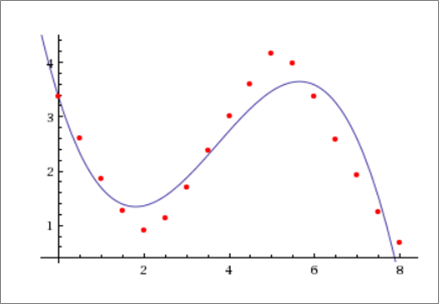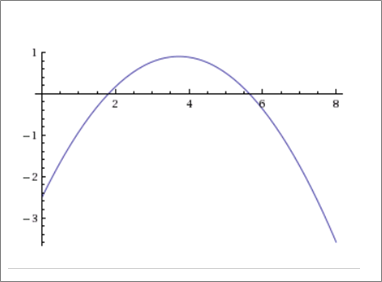
Concept explainers
a.
To estimate: when Priya is moving toward the motion detector, away from the motion detector.
a.
Answer to Problem 58E
: moving towards the motion detector again.
Between 1.5 and 2.5 there is a
t = 2.
Between 4.5 and 5.5 there is a
t = 5.
Explanation of Solution
Given information: Priya’s distance D in meters from a motion detector is given by the
data in below table.
| t (sec) | D (m) | t (sec) | D (m) |
| 0.0 | 3.36 | 4.5 | 3.59 |
| 0.5 | 2.61 | 5.0 | 4.15 |
| 1.0 | 1.86 | 5.5 | 3.99 |
| 1.5 | 1.27 | 6.0 | 3.37 |
| 2.0 | 0.91 | 6.5 | 2.58 |
| 2.5 | 1.14 | 7.0 | 1.93 |
| 3.0 | 1.69 | 7.5 | 1.25 |
| 3.5 | 2.37 | 8.0 | 0.67 |
| 4.0 | 3.01 |
Calculation:
D (t) is increasing when Priya is moving away and decreasing when moving towards the motion detector.
: moving towards the motion detector again.
Between 1.5 and 2.5 there is a local minimum, but cannot be sure about the direction at
t = 2.
Between 4.5 and 5.5 there is a local maximum, but cannot be sure about the direction at
t = 5.
b.
To give: an interpretation of any local extreme values in term of this problem situation.
b.
Answer to Problem 58E
At t = 2 Priya is at relative minimum distance to the detector . At t = 5 Priya is at a relative maximum distance from the detector.
Explanation of Solution
Calculation:
At t = 2 Priya is at relative minimum distance to the detector . At t = 5 Priya is at a relative maximum distance from the detector.
c.
To find: a cubic regression equation for the table data and superimpose its graph on a
c.
Answer to Problem 58E
Explanation of Solution
Calculation:
The cubic regression equation for the table data using graphing utility is:
The graph of the above model is shown below.

d.
To find: a formula for f’ using the model in part (c) and use this formula to estimate the answers to (a).
d.
Answer to Problem 58E
Interval:
(0, 1.8) − moving towards door.
(1.8, 5.6) − moving away.
(5.6, 8) − moving towards.
Explanation of Solution
Given information:
Calculation:
The graph of the f’ (t) is shown below.

From the graph:
When f’ (t) < 0 .the distance f (t) is decreasing.
When f’ (t) >0 . the distance f (t) is increasing.
Interval:
(0, 1.8) − moving towards door.
(1.8, 5.6) − moving away.
(5.6, 8) − moving towards.
Chapter 5 Solutions
Calculus: Graphical, Numerical, Algebraic
Additional Math Textbook Solutions
University Calculus: Early Transcendentals (4th Edition)
A Problem Solving Approach To Mathematics For Elementary School Teachers (13th Edition)
A First Course in Probability (10th Edition)
Basic Business Statistics, Student Value Edition
Elementary Statistics (13th Edition)
Elementary Statistics: Picturing the World (7th Edition)
- The spread of an infectious disease is often modeled using the following autonomous differential equation: dI - - BI(N − I) − MI, dt where I is the number of infected people, N is the total size of the population being modeled, ẞ is a constant determining the rate of transmission, and μ is the rate at which people recover from infection. Close a) (5 points) Suppose ẞ = 0.01, N = 1000, and µ = 2. Find all equilibria. b) (5 points) For the equilbria in part a), determine whether each is stable or unstable. c) (3 points) Suppose ƒ(I) = d. Draw a phase plot of f against I. (You can use Wolfram Alpha or Desmos to plot the function, or draw the dt function by hand.) Identify the equilibria as stable or unstable in the graph. d) (2 points) Explain the biological meaning of these equilibria being stable or unstable.arrow_forwardFind the indefinite integral. Check Answer: 7x 4 + 1x dxarrow_forwardshow sketcharrow_forward
- Find the indefinite integral. Check Answer: 7x 4 + 1x dxarrow_forwardQuestion 1: Evaluate the following indefinite integrals. a) (5 points) sin(2x) 1 + cos² (x) dx b) (5 points) t(2t+5)³ dt c) (5 points) √ (In(v²)+1) 4 -dv ขarrow_forwardFind the indefinite integral. Check Answer: In(5x) dx xarrow_forward
- Find the indefinite integral. Check Answer: 7x 4 + 1x dxarrow_forwardHere is a region R in Quadrant I. y 2.0 T 1.5 1.0 0.5 0.0 + 55 0.0 0.5 1.0 1.5 2.0 X It is bounded by y = x¹/3, y = 1, and x = 0. We want to evaluate this double integral. ONLY ONE order of integration will work. Good luck! The dA =???arrow_forward43–46. Directions of change Consider the following functions f and points P. Sketch the xy-plane showing P and the level curve through P. Indicate (as in Figure 15.52) the directions of maximum increase, maximum decrease, and no change for f. ■ 45. f(x, y) = x² + xy + y² + 7; P(−3, 3)arrow_forward
 Calculus: Early TranscendentalsCalculusISBN:9781285741550Author:James StewartPublisher:Cengage Learning
Calculus: Early TranscendentalsCalculusISBN:9781285741550Author:James StewartPublisher:Cengage Learning Thomas' Calculus (14th Edition)CalculusISBN:9780134438986Author:Joel R. Hass, Christopher E. Heil, Maurice D. WeirPublisher:PEARSON
Thomas' Calculus (14th Edition)CalculusISBN:9780134438986Author:Joel R. Hass, Christopher E. Heil, Maurice D. WeirPublisher:PEARSON Calculus: Early Transcendentals (3rd Edition)CalculusISBN:9780134763644Author:William L. Briggs, Lyle Cochran, Bernard Gillett, Eric SchulzPublisher:PEARSON
Calculus: Early Transcendentals (3rd Edition)CalculusISBN:9780134763644Author:William L. Briggs, Lyle Cochran, Bernard Gillett, Eric SchulzPublisher:PEARSON Calculus: Early TranscendentalsCalculusISBN:9781319050740Author:Jon Rogawski, Colin Adams, Robert FranzosaPublisher:W. H. Freeman
Calculus: Early TranscendentalsCalculusISBN:9781319050740Author:Jon Rogawski, Colin Adams, Robert FranzosaPublisher:W. H. Freeman
 Calculus: Early Transcendental FunctionsCalculusISBN:9781337552516Author:Ron Larson, Bruce H. EdwardsPublisher:Cengage Learning
Calculus: Early Transcendental FunctionsCalculusISBN:9781337552516Author:Ron Larson, Bruce H. EdwardsPublisher:Cengage Learning





